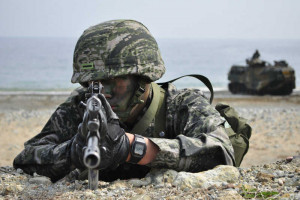
This time, the situation is unfolding as usual – On August 22, 2016, the military forces of South Korea and the USA launched their annual two-week military manoeuvres, Ulchi Freedom Guardian, which are “integrated in nature and are command-staff exercises, which do not provide the movement of equipment.”
In fact, 50 thousand military personnel of South Korea, 25 thousand soldiers and military officers from the USA, including 2,500 American service members from foreign military bases participate in these manoeuvres. In addition, representatives of nine other members states of the UN troops command are involved in the exercise: Australia, Great Britain, Denmark, Italy, Canada, Columbia, New Zealand, the Philippines and France. Military personnel from Switzerland and Sweden participate as observers.
Ulchi Freedom Guardian consists of two stages. The first stage involves training to eliminate the consequences of various levels of damage caused to vital facilities. The aim of the second stage is training of joint actions of the South Korean and US troops in case of the North Korean invasion under simulated battlefield conditions.
Simultaneously, South Korea conducts civil defence exercises. According to South Korean media, almost all the state structures of the country – about four thousand ministries, departments, government agencies, organisations and up to 480 thousand civil servants of different types – participate in these exercises. These exercises involve training of actions in case of a long-range missile launch by North Korea, cyber attacks, attempts to create interference and blocking global positioning systems, threats of terrorist attacks, and so on.
On the day of the beginning of the military manoeuvres, the President of South Korea, Park Geun-hye, held a meeting of the National Security Council. She reminded attendees that the North Korean authorities continue to put pressure on its citizens using “the policy of fear” and fail to pay attention to the life of the country’s citizens. In this situation, the probability of terrorist attacks, cyber attacks and other provocative actions on the part of North Korea is growing.
The North traditionally called the exercises a provocation, and threatened that “from that moment on, units of the first echelon of the Korean People’s Army are in constant combat readiness for a pre-emptive strike of retribution against all the enemy offensive groups involved in the current military manoeuvres.” Naturally, in response to the discovery of signs of the immediate preparation for an attack, “we will turn the source of provocation into flames with a merciless preventive nuclear strike.” As confirmation of North Korea’s determination, the country conducted military exercises that simulated the detonation of nuclear warheads mounted on missiles that are directed at ports, airports and other key facilities in South Korea. In addition, it conducted a demonstrative launch of SLBM.
This only makes one exclaim: “Enough already!” This topic is abundant, but it is impossible to write once again the same things about the double standards that mean the regular, open provocative actions are declared as a “fight against provocations of the other party.” Moreover, there are two clear and simple versions of the solution to such disputable situations.
The first one is based on the idea that as long as one or the other party does not violate certain limits, it is their right to practice whatever and however they want. If the United States wishes to carry out a training exercise on conquering North Korea, and even builds a miniature Pyongyang to conduct training tank battles, North Korea may be indignant, but this indignation is just hot air. However, Washington has no right to complain if North Korea conducts similar manoeuvres using a miniature of the White House. Neither of the actions should give reason for additional sanctions, international condemnation or speeches about evil provocations and threats to the world.
The second version is that the international law system should strictly forbid any provocations. Then it does not matter which party uses portraits of the president of the other party as targets. In this case, both those who uses a portrait of Park Geun-hye as a target, and those who deliberately pierce a target with the face of Kim Jong-un and film it must be criticized, as there is in fact no difference between these actions.
Growing military tension in terms of constant exercises and demonstrative docking of US aircraft carriers and submarines in South Korean ports destabilize the situation more often and no less than the North Korean missile launches or threatening statements. It is no coincidence that in a number of statements, Moscow and Beijing wag their fingers not at North Korea in particular, but at the forces that are increasing tension on the peninsula, that is – both sides.
It should not be left unsaid that this time the number of US representatives totals 5,000 fewer than last year. On the eve of manoeuvres, North Korea was informed about their launch via loud speakers in the area between the Korean border (other communication channels are frozen at the moment). But I would like to highlight that such protecting measures took place a year after an incident occurred in the demilitarized zone due to South Korean disorderliness, and it was decided to blame the North. It nearly came to serious conflict, but the fighting was settled with considerable effort.
That is why, on the one hand we explain every time that “it will hurt for a bit then feel better,” but, on the other hand, the low probability that the aggravation may, alas, go too far always remains. However, we always hope that the danger will soon be over.
Konstantin Asmolov, Ph.D. in History, Chief Research Fellow at the Center for Korean Studies of the Institute of Far Eastern Studies of the Russian Academy of Sciences, exclusively for the online magazine “New Eastern Outlook”
